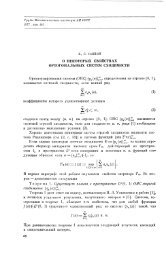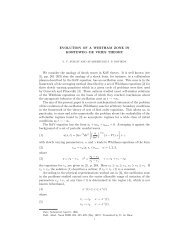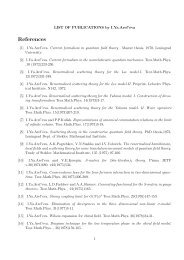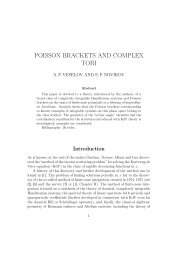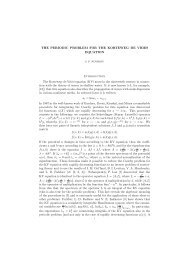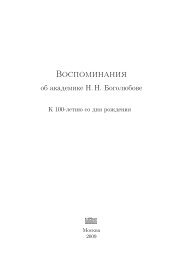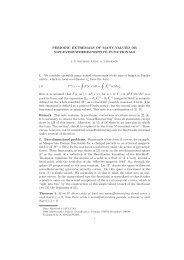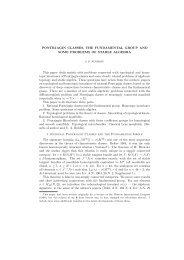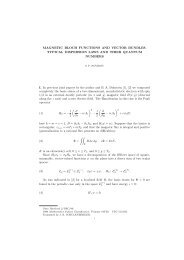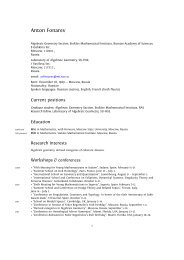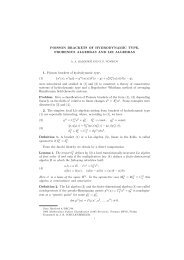A simple proof of Bazzi's theorem
A simple proof of Bazzi's theorem
A simple proof of Bazzi's theorem
You also want an ePaper? Increase the reach of your titles
YUMPU automatically turns print PDFs into web optimized ePapers that Google loves.
A <strong>simple</strong> <strong>pro<strong>of</strong></strong> <strong>of</strong> Bazzi’s <strong>theorem</strong><br />
Alexander A. Razborov ∗<br />
September 10, 2008<br />
Abstract<br />
In 1990, Linial and Nisan asked if any polylog-wise independent<br />
distribution fools any function in AC 0 . In a recent remarkable development,<br />
Bazzi solved this problem for the case <strong>of</strong> DNF formulas. The<br />
aim <strong>of</strong> this note is to present a simplified version <strong>of</strong> his <strong>pro<strong>of</strong></strong>.<br />
In the 1990s, it was shown in a series <strong>of</strong> papers [LMN93, BRS91, ABFR94]<br />
that Boolean functions computable by constant depth polynomial size circuits<br />
can be well approximated (in various contexts) by low degree polynomials.<br />
Around the same time, Linial and Nisan [LN90] conjectured that<br />
any such function can be fooled by a polylog-wise 1 independent probability<br />
distribution. By linear duality, this conjecture is an approximation problem<br />
<strong>of</strong> precisely the kind considered in [LMN93, BRS91, ABFR94]. Therefore,<br />
it is quite remarkable that the only noticeable progress in this direction was<br />
achieved only last year by Bazzi [Baz07]. Namely, he showed that any DNF<br />
formula <strong>of</strong> polynomial size is fooled by (any) O(log n) 2 -independent distribution.<br />
We refer the reader to [Baz07] for motivations and applications <strong>of</strong><br />
this result; the purpose <strong>of</strong> this note is to give a simplified version <strong>of</strong> Bazzi’s<br />
<strong>pro<strong>of</strong></strong>.<br />
For a probability distribution µ on {0, 1} n and a function f : {0, 1} n −→<br />
R, E µ (f) is the expected value <strong>of</strong> f w.r.t. this distribution (in particular, if f :<br />
∗ University <strong>of</strong> Chicago, US and Steklov Mathematical Institute, Moscow, Russia,<br />
razborov@cs.uchicago.edu. Supported by the Russian Foundation for Basic Research.<br />
1 As literally stated in [LN90] the conjecture is false [LV96], so we relax the parameters<br />
appropriately.<br />
1
{0, 1} n −→ {0, 1} is a Boolean function then E µ (f) = P x∼µ [f(x) = 1] is the<br />
probability that f(x) = 1). If µ is uniform on {0, 1} n , E µ (f) is abbreviated<br />
to E(f). The bias <strong>of</strong> f w.r.t. µ is defined as |E µ (f) − E(f)|, and for an<br />
integer k ≥ 0, bias(f; k) def = max µ |E µ (f) − E(f)|, where the maximum is<br />
taken over all k-independent probability distributions on {0, 1} n .<br />
In this note we give a simplified <strong>pro<strong>of</strong></strong> <strong>of</strong> the following <strong>theorem</strong>:<br />
Theorem 1 (Bazzi [Baz07]) If the Boolean function f : {0, 1} n −→ {0, 1}<br />
is computable by an m-term DNF formula then bias(f; k) ≤ m O(1) exp(−Ω( √ k)).<br />
From now on we will identify a DNF formula F = A 1 ∨ . . . ∨ A m and the<br />
Boolean function it represents. The first step in the <strong>pro<strong>of</strong></strong> <strong>of</strong> Theorem 1 is<br />
to reduce the problem to the case when every conjunctive term A i has only<br />
a few variables, that is F is an s-DNF for a sufficiently small s. This <strong>simple</strong><br />
step is borrowed from [Baz07] without any changes:<br />
Lemma 2 ([Baz07]) Let k ≥ s ≥ 1 be integers, and F be an m-term DNF.<br />
Then<br />
bias(F ; k) ≤ max<br />
G bias(G; k) + m2−s ,<br />
where the maximum is taken over all m-terms s-DNF G.<br />
The next relatively <strong>simple</strong> step in Bazzi’s <strong>pro<strong>of</strong></strong> that we also reproduce<br />
here without alterations is to estimate the bias <strong>of</strong> an s-DNF F in terms <strong>of</strong> a<br />
constrained version <strong>of</strong> l 2 -approximation by low degree polynomials called in<br />
[Baz07] zero-energy. Let us first recall the unconstrained version.<br />
Definition 3 For a function f : {0, 1} n −→ R and an integer t ≥ 0, let<br />
energy(f; t) def = min<br />
deg(g)≤t E((f − g)2 ).<br />
This quantity is equal to the sum <strong>of</strong> squares ∑ |S|>t ̂f(S) 2 <strong>of</strong> high order<br />
Fourier coefficients <strong>of</strong> f. But we do not need this interpretation in our <strong>pro<strong>of</strong></strong>,<br />
besides making connection to the following celebrated result by Linial, Mansour<br />
and Nisan [LMN93]:<br />
Lemma 4 ([LMN93]) If f is a Boolean function computable by an {¬, ∧, ∨}-<br />
circuit <strong>of</strong> size m and depth d then for any t > 0,<br />
energy(f; t) ≤ 2m · 2 −t1/d /20 .<br />
2
Definition 5 ([Baz07])<br />
zeroEnergy(f; t) def = min<br />
deg(g)≤t E((f − g)2 ),<br />
where this time the minimum is taken over all degree ≤ d polynomials g<br />
that satisfy one additional zero-constraint: g(x) = 0 whenever f(x) = 0<br />
(x ∈ {0, 1} n ).<br />
Also, bias is related to zero-<br />
Clearly, energy(f; t) ≤ zeroEnergy(f; t).<br />
energy with the following lemma:<br />
Lemma 6 ([Baz07]) Let F be an m-term s-DNF formula and let k ≥ s be<br />
an integer. Then<br />
bias(F ; k) ≤ m · zeroEnergy (F ; ⌊(k − s)/2⌋) .<br />
In the opposite direction, bounding zero-energy in terms <strong>of</strong> energy <strong>of</strong> certain<br />
auxiliary functions is where the bulk <strong>of</strong> work is done in Bazzi’s <strong>pro<strong>of</strong></strong>. And<br />
this is where our simplification comes in:<br />
Theorem 7 Let F be an m-term s-DNF and t be an integer. Then<br />
zeroEnergy(F ; t) ≤ m 2 · max energy(G; t − s), (1)<br />
G<br />
where the maximum is again taken over all m-term s-DNF formulas G.<br />
Pro<strong>of</strong>. Let F = A 1 ∨ . . . ∨ A m , where A i are conjunctive terms <strong>of</strong> size ≤ s<br />
each. We claim that F can be expressed in the form<br />
m∑<br />
F = A i (1 − E[G i ]), (2)<br />
i=1<br />
where G i are specially constructed random sub-DNFs <strong>of</strong> F and the expectation<br />
sign is understood pointwise: E[G] (x) def = E[G(x)] (x ∈ {0, 1}) n . But<br />
before exhibiting the distributions <strong>of</strong> G i with this property, let us see why<br />
their mere existence already implies the statement <strong>of</strong> Theorem 7.<br />
Indeed, denoting the maximum max G energy(G; t−s) in (1) by ɛ, we have<br />
(random) polynomials g i <strong>of</strong> degree ≤ t − s such that with probability one we<br />
have the bound E((G i − g i ) 2 ) ≤ ɛ. And now we simply let<br />
g def =<br />
m∑<br />
A i (1 − E[g i ]).<br />
i=1<br />
3
Since every term A i has at most s variables, deg(g) ≤ t. F (x) = 0 implies<br />
∀i ∈ [m](A i (x) = 0) which in turn implies g(x) = 0. Therefore, g satisfies the<br />
zero-constraint. And we bound the l 2 -distance between F and g as follows:<br />
⎛( m<br />
) ⎞<br />
E((F − g) 2 ∑<br />
2<br />
) = E ⎝ A i · E[G i − g i ] ⎠<br />
i=1<br />
m∑<br />
≤ Cauchy-Schwartz m · E ( (A i · E[G i − g i ]) 2)<br />
i=1<br />
m∑<br />
≤ since |Ai |≤1 m · E ( E[G i − g i ] 2)<br />
i=1<br />
m∑<br />
≤ Cauchy-Schwartz m · E ( E [ (G i − g i ) 2])<br />
i=1<br />
m∑<br />
= m · E [ E ( (G i − g i ) 2)] ≤ ɛm 2 .<br />
i=1<br />
It remains to exhibit G 1 , . . . , G m such that the identity (2) holds. For<br />
that purpose, we first pick p ∈ [0, 1] uniformly at random. And then we let<br />
G i be the sub-DNF <strong>of</strong> (A 1 ∨ . . . ∨ A i−1 ∨ A i+1 ∨ . . . ∨ A m ) in which every term<br />
is removed, independently <strong>of</strong> others, with probability p and kept alive with<br />
probability 1 − p.<br />
Fix an input x ∈ {0, 1} n , and let w def = | {i ∈ [m] | A i (x) = 1} |. If w = 0<br />
then both sides <strong>of</strong> (2) are equal to 0.<br />
If, on the other hand, w > 0 then there are precisely w non-zero terms in<br />
the expression ∑ m<br />
i=1 A i (x)(1−E[G i ] (x)). And every one <strong>of</strong> them contributes<br />
to the sum precisely<br />
∫ 1<br />
0<br />
(1 − E[G i (x) |p = p])dp =<br />
∫ 1<br />
0<br />
P[G i (x) = 0 |p = p] dp =<br />
∫ 1<br />
0<br />
p w−1 dp = 1 w .<br />
Thus, ∑ m<br />
i=1 A i (x)(1 − E[G i ] (x)) = 1 (w > 0), and this completes the <strong>pro<strong>of</strong></strong><br />
<strong>of</strong> (2) and <strong>of</strong> Theorem 7.<br />
Like in Bazzi’s <strong>pro<strong>of</strong></strong>, Theorem 1 immediately follows from Lemma 2,<br />
Lemma 6, Theorem 7 and Lemma 4.<br />
Remark. After the preliminary version <strong>of</strong> this note was disseminated,<br />
Avi Wigderson observed that the <strong>pro<strong>of</strong></strong> can be further simplified by (deterministically!)<br />
letting G i in (2) be equal A 1 ∨ . . . ∨ A i−1 . This is definitely<br />
4
<strong>simple</strong>r, but our version has the potential advantage <strong>of</strong> being more symmetric.<br />
Acknowledgement. I am grateful to Scott Aaronson for useful discussions<br />
that essentially triggered <strong>of</strong>f this work, to Louay Bazzi for carefully<br />
checking the correctness <strong>of</strong> the <strong>pro<strong>of</strong></strong> and to Avi Wigderson for his permission<br />
to include here the observation above.<br />
References<br />
[ABFR94] J. Aspnes, R. Beigel, M. Furst, and S. Rudich. The expressive<br />
power <strong>of</strong> voting polynomials. Combinatorica, 14(2):1–14, 1994.<br />
[Baz07] L. Bazzi. Polylogarithmic independence can<br />
fool DNF formulas. Manuscript, available at<br />
http://www.mit.edu/~louay/recent/kwisednf2.pdf, 2007.<br />
[BRS91]<br />
R. Beigel, N. Reingold, and D. Spielman. The perceptron strikes<br />
back. In Proceedings <strong>of</strong> the 6th IEEE Conference on Structure in<br />
Complexity Theory, pages 286–291, 1991.<br />
[LMN93] N. Linial, Y. Mansour, and N. Nisan. Constant depth circuits,<br />
Fourier transforms and learnability. Journal <strong>of</strong> the ACM,<br />
40(3):607–620, 1993.<br />
[LN90]<br />
[LV96]<br />
N. Linial and N. Nisan. Approximate inclusion-exclusion. Combinatorica,<br />
10(4):349–365, 1990.<br />
M. Luby and B. Velickovic. On deterministic approximation <strong>of</strong><br />
DNF. Algorithmica, 16(4/5):415–433, 1996.<br />
5



